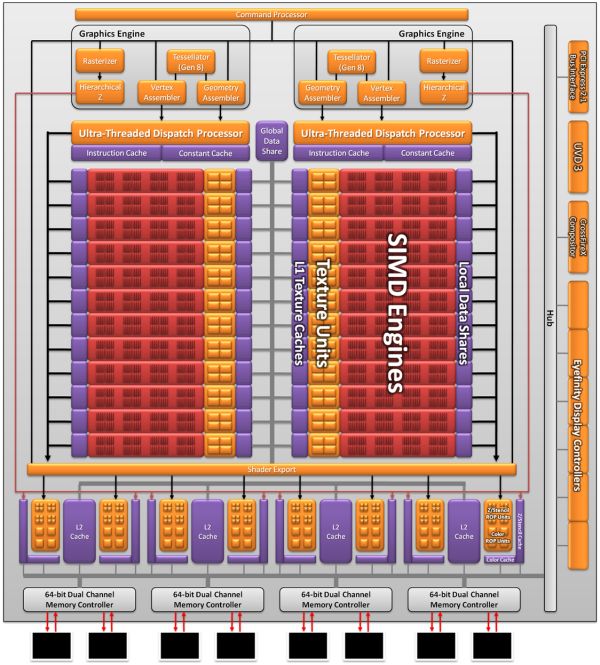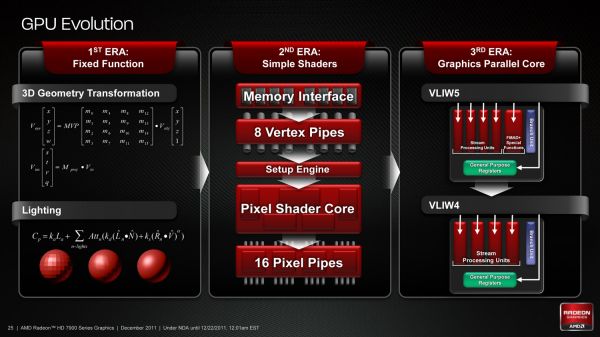AMD Radeon HD 7970 Review: 28nm And Graphics Core Next, Together As One
by Ryan Smith on December 22, 2011 12:00 AM EST- Posted in
- GPUs
- AMD
- Radeon
- ATI
- Radeon HD 7000
A Quick Refresher: Graphics Core Next
One of the things we’ve seen as a result of the shift from pure graphics GPUs to mixed graphics and compute GPUs is how NVIDIA and AMD go about making their announcements and courting developers. With graphics GPUs there was no great need to discuss products or architectures ahead of time; a few choice developers would get engineering sample hardware a few months early, and everyone else would wait for the actual product launch. With the inclusion of compute capabilities however comes the need to approach launches in a different manner, a more CPU-like manner.
As a result both NVIDIA and AMD have begun revealing their architectures to developers roughly six months before the first products launch. This is very similar to how CPU launches are handled, where the basic principles of an architecture are publically disclosed months in advance. All of this is necessary as the compute (and specifically, HPC) development pipeline is far more focused on optimizing code around a specific architecture in order to maximize performance; whereas graphics development is still fairly abstracted by APIs, compute developers want to get down and dirty, and to do that they need to know as much about new architectures as possible as soon as possible.
It’s for these reasons that AMD announced Graphics Core Next, the fundamental architecture behind AMD’s new GPUs, back in June of this year at the AMD Fusion Developers Summit. There are some implementation and product specific details that we haven’t known until now, and of course very little was revealed about GCN’s graphics capabilities, but otherwise on the compute side AMD is delivering on exactly what they promised 6 months ago.
Since we’ve already covered the fundamentals of GCN in our GCN preview and the Radeon HD 7970 is primarily a gaming product we’re not going to go over GCN in depth here, but I’d encourage you to read our preview to fully understand the intricacies of GCN. But if you’re not interested in that, here’s a quick refresher on GCN with details pertinent to the 7970.
As we’ve already seen in some depth with the Radeon HD 6970, VLIW architectures are very good for graphics work, but they’re poor for compute work. VLIW designs excel in high instruction level parallelism (ILP) use cases, which graphics falls under quite nicely thanks to the fact that with most operations pixels and the color component channels of pixels are independently addressable datum. In fact at the time of the Cayman launch AMD found that the average slot utilization factor for shader programs on their VLIW5 architecture was 3.4 out of 5, reflecting the fact that most shader operations were operating on pixels or other data types that could be scheduled together
Meanwhile, at a hardware level VLIW is a unique design in that it’s the epitome of the “more is better” philosophy. AMD’s high steam processor counts with VLIW4 and VLIW5 are a result of VLIW being a very thin type of architecture that purposely uses many simple ALUs, as opposed to fewer complex units (e.g. Fermi). Furthermore all of the scheduling for VLIW is done in advance by the compiler, so VLIW designs are in effect very dense collections of simple ALUs and cache.
The hardware traits of VLIW mean that for a VLIW architecture to work, the workloads need to map well to the architecture. Complex operations that the simple ALUs can’t handle are bad for VLIW, as are instructions that aren’t trivial to schedule together due to dependencies or other conflicts. As we’ve seen graphics operations do map well to VLIW, which is why VLIW has been in use since the earliest pixel shader equipped GPUs. Yet even then graphics operations don’t achieve perfect utilization under VLIW, but that’s okay because VLIW designs are so dense that it’s not a big problem if they’re operating at under full efficiency.
When it comes to compute workloads however, the idiosyncrasies of VLIW start to become a problem. “Compute” covers a wide range of workloads and algorithms; graphics algorithms may be rigidly defined, but compute workloads can be virtually anything. On the one hand there are compute workloads such as password hashing that are every bit as embarrassingly parallel as graphics workloads are, meaning these map well to existing VLIW architectures. On the other hand there are tasks like texture decompression which are parallel but not embarrassingly so, which means they map poorly to VLIW architectures. At one extreme you have a highly parallel workload, and at the other you have an almost serial workload.

Cayman, A VLIW4 Design
So long as you only want to handle the highly parallel workloads VLIW is fine. But using VLIW as the basis of a compute architecture is going is limit what tasks your processor is sufficiently good at. If you want to handle a wider spectrum of compute workloads you need a more general purpose architecture, and this is the situation AMD faced.
But why does AMD want to chase compute in the first place when they already have a successful graphics GPU business? In the long term GCN plays a big part in AMD’s Fusion plans, but in the short term there’s a much simpler answer: because they have to.
In Q3’2011 NVIDIA’s Professional Solutions Business (Quadro + Tesla) had an operating income of 95M on 230M in revenue. Their (consumer) GPU business had an operating income of 146M, but on a much larger 644M in revenue. Professional products have much higher profit margins and it’s a growing business, particularly the GPU computing side. As it stands NVIDIA and AMD may have relatively equal shares of the discrete GPU market, but it’s NVIDIA that makes all the money. For AMD’s GPU business it’s no longer enough to focus only on graphics, they need a larger piece of the professional product market to survive and thrive in the future. And thus we have GCN.











292 Comments
View All Comments
RussianSensation - Thursday, December 22, 2011 - link
That's not what the review says. The review clearly explains that it's the best single-GPU for gaming. There is nothing biased about not being mind-blown by having a card that's only 25% faster than GTX580 and 37% faster than HD6970 on average, considering this is a brand new 28nm node. Name a single generation where AMD's next generation card improved performance so little since Radeon 8500?There isn't any!
SlyNine - Friday, December 23, 2011 - link
2900XT ? But I Don't remember if that was a new node and what the % of improvement was beyond the 1950XT.But still this is a 500$ card, and I don't think its what we have come to expect from a new node and generation of card. However some people seem more then happy with it, Guess they don't remember the 9700PRO days.
takeulo - Thursday, December 22, 2011 - link
as ive read the review this is not a disappointment infact its only a single gpu card but it toughly competing or nearly chasing with the dual gpu's graphics card like 6990 and gtx 590 performance...imagine that 7970 is also a dual gpu?? it will tottally dominate the rest... sorry for my bad english..
eastyy - Thursday, December 22, 2011 - link
the price vs performance is the most important thing for me at the moment i have a 460 that cost me about £160 at the time and that was a few years ago...seems like the cards now for the same price dont really give that much of a increaseMorg. - Thursday, December 22, 2011 - link
What seems unclear to the writer here is that in fact 6-series AMD was better in single GPU than nVidia.Like miles better.
First, the stock 6970 was within 5% of the gtx580 at high resolutions (and excuse me, but if you like a 500 bucks graphics board with a 100 bucks screen ... not my problem -- ).
Second, if you put a 6970 OC'd at GTX580 TDP ... the GTX580 is easily 10% slower.
So overall . seriously ... wake the f* up ?
The only thing nVidia won at with fermi series 2 (gtx5xx) is making the most expensive highest TDP single GPU card. It wasn't faster, they just picked a price point AMD would never target .. and they got i .. wonderful.
However, AMD raped nVidia all the way in perf/watt/dollar as they did with Intel in the Server CPU space since Opteron Istanbul ...
If people like you stopped spouting random crap, companies like AMD would stand a chance of getting the market share their products deserve (sure their drivers are made of shit).
Leyawiin - Thursday, December 22, 2011 - link
The HD 7970 is a fantastic card (and I can't wait to see the rest of the line), but the GTX 580 was indisputably better than the HD 6970. Stock or OC'd (for both).Morg. - Friday, December 23, 2011 - link
Considering TDP, price and all - no.The 6970 lost maximum 5% to the GTX580 above full HD, and the bigger the resolution, the smaller the GTX advantage.
Every benchmark is skewed, but you should try interpreting rather than just reading the conclusion --
Keep in mind the GTX580 die size is 530mm² whereas the 6970 is 380mm²
Factor that in, aim for the same TDP on both cards . and believe me .. the GTX580 was a complete total failure, and a total loss above full HD.
Yes it WAS the biggest single GPU of its time . but not the best.
RussianSensation - Thursday, December 22, 2011 - link
Your post is ill-informed.When GTX580 and HD6970 are both overclocked, it's not even close. GTX580 destroyed it.
http://www.xbitlabs.com/articles/graphics/display/...
HD6950 was an amazing value card for AMD this generation, but HD6970 was nothing special vs. GTX570. GTX580 was overpriced for the performance over even $370 factory preoverclocked GTX570 cards (such as the almost eerily similar in performance EVGA 797mhz GTX570 card for $369).
All in all, GTX460 ~ HD6850, GTX560 ~ HD6870, GTX560 Ti ~ HD6950, GTX570 ~ HD6970. The only card that had really poor value was GTX580. Of course if you overclocked it, it was a good deal faster than the 6970 that scaled poorly with overclocking.
Morg. - Friday, December 23, 2011 - link
I believe you don't get what I said :AT THE SAME TDP, THE HD6xxx TOTALLY DESTROYED THE GTX 5xx
THAT MEANS : the amd gpu was better even though AMD decided to sell it at a TDP / price point that made it cheaper and less performing than the GTX 5xx
The "destroyed it" statement is full HD resolution only . which is dumb . I wouldn't ever get a top graphics board to just stick with full HD and a cheap monitor.
Peichen - Friday, December 23, 2011 - link
According to your argument, all we'd ever need is IGP because no stand-alone card can compete with IGP at the same TDP / price point.